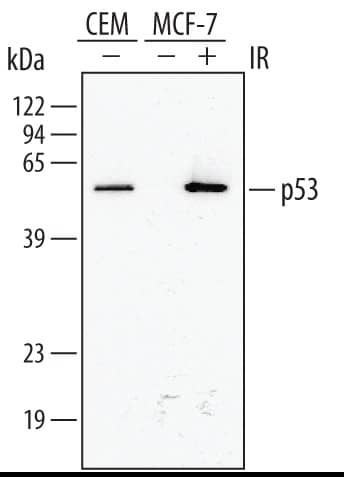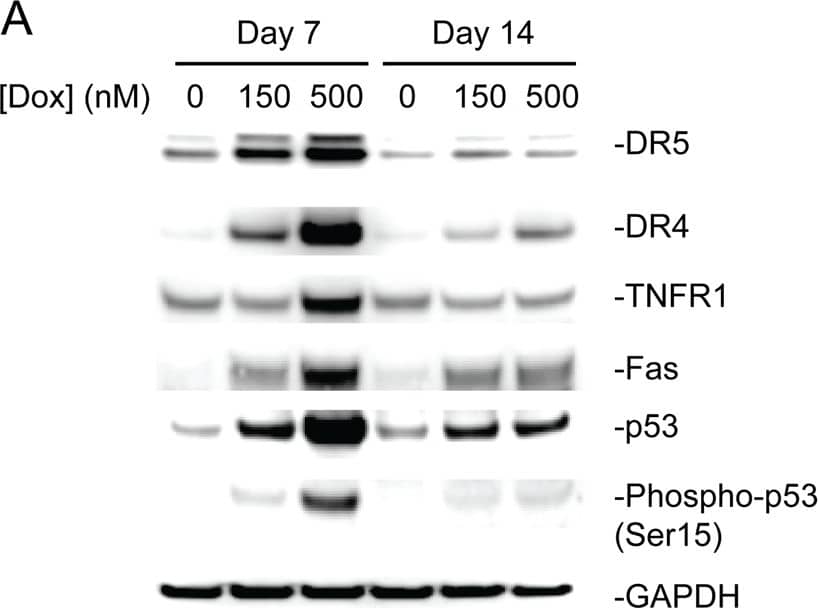Human/Mouse/Rat p53 HRP-conjugated Antibody
R&D Systems, part of Bio-Techne | Catalog # HAF1355


Key Product Details
Validated by
Species Reactivity
Validated:
Cited:
Applications
Validated:
Cited:
Label
Antibody Source
Product Specifications
Immunogen
Asp7-Asp393
Accession # P04637
Specificity
Clonality
Host
Isotype
Scientific Data Images for Human/Mouse/Rat p53 HRP-conjugated Antibody
Detection of Human p53 by Western Blot.
Western blot shows lysates of CEM human T‑lymphoblastoid cell line and MCF‑7 human breast cancer cell line untreated (-) or treated (+) with 10 Gy ionizing radiation (IR) for 1 hour. PVDF membrane was probed with 1:5000 dilution of Human/Mouse/Rat p53 HRP-conjugated Antigen Affinity-purified Polyclonal Antibody (Catalog # HAF1355). A specific band was detected for p53 at approximately 53 kDa (as indicated). This experiment was conducted under reducing conditions and using Immunoblot Buffer Group 1.Detection of Human p53 by Western Blot
Western blotting confirmed doxorubicin-induced increase in expression of p53 and DRs.a Immunoblot and b densitometric quantification demonstrate after exposing cardiomyocytes to 150 nM or 500 nM of doxorubicin for 48 h the phosphorylation of p53 and total expression of p53, TNFR1, DR4, DR5, and Fas increase. TNFR1 protein expression increased only after exposure to 500 nM of doxorubicin. The protein expression of p53 targets, DR4 and DR5, decrease after a 7-day washout period. Fas remains slightly upregulated after 7-day washout Image collected and cropped by CiteAb from the following publication (https://pubmed.ncbi.nlm.nih.gov/31231550), licensed under a CC-BY license. Not internally tested by R&D Systems.Applications for Human/Mouse/Rat p53 HRP-conjugated Antibody
Western Blot
Sample: CEM human T-lymphoblastoid cell line and ionizing radiation-treated MCF-7 human breast cancer cell line
Reviewed Applications
Read 1 review rated 5 using HAF1355 in the following applications:
Formulation, Preparation, and Storage
Purification
Formulation
Shipping
Stability & Storage
- 6 months from date of receipt, 2 to 8 °C as supplied.
Background: p53
The p53 tumor suppressor protein is a multi-functional transcription factor that regulates cellular decisions regarding proliferation, cell cycle checkpoints, and apoptosis. The importance of p53 is underscored by its mutation in over 50% of human cancers. Mice that lack one or both copies of p53 also showed an increased incidence of tumors, which makes the p53 deficient mouse a model system for studying cancer generation and progression.
Alternate Names
Gene Symbol
UniProt
Additional p53 Products
Product Documents for Human/Mouse/Rat p53 HRP-conjugated Antibody
Product Specific Notices for Human/Mouse/Rat p53 HRP-conjugated Antibody
For research use only
